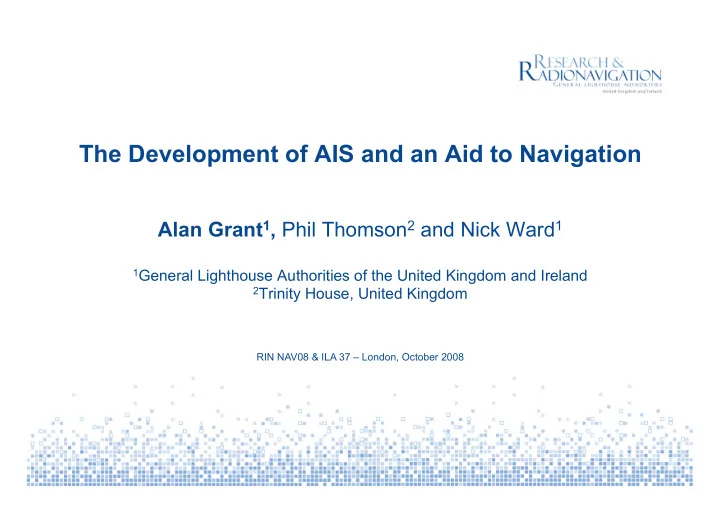

The Development of AIS and an Aid to Navigation Alan Grant 1 , Phil Thomson 2 and Nick Ward 1 1 General Lighthouse Authorities of the United Kingdom and Ireland 2 Trinity House, United Kingdom RIN NAV08 & ILA 37 – London, October 2008
Introduction to AIS The International Maritime Organisation (IMO) mandated the use of AIS by all vessels covered by the Safety of Life at Sea (SOLAS) convention (vessels over 300 tonnes or those carrying passengers) to be fitted by July 2004.
Introduction to AIS Static information Name, call sign MMSI Dimensions Type Voyage related information Draught Cargo type Destination ETA Dynamic information Position – LAT/LNG Course and speed over ground Heading Rate of turn
AIS as an Aid to Navigation (AtoN) AIS can be used to provide: Virtual AtoN Synthetic AtoN AtoN AIS AIS was officially declared a beacon in an amendment of the merchant shipping act in 2006.
Virtual AtoNs No physical AtoN exists A local AIS base station V broadcasts information about the AtoN so that it appears on the vessels ECDIS. The mariner is able to “see” the AtoN and ECDIS AIS Base station interrogate it to seek additional information. Incidents can be marked in a timely manner before physical AtoNs are deployed
Synthetic AtoNs A physical AtoN is present. A local AIS base station broadcasts information about the AtoN as if it was from the AtoN itself. If the AtoN is linked to the ECDIS base station then the true AIS Base station position can be broadcast to the mariner. The mariner is able to monitor the AtoN through AIS.
AtoN AIS A physical AtoN is present and fitted with an AtoN AIS unit. The AtoN AIS unit broadcasts information on the AtoN, including: ECDIS • Current position • AtoN status • Control information • 3rd party information (Weather, etc)
AIS Demonstrations The benefits of AIS as an AtoN have been demonstrated in two events this year. Oban Virtual AtoNs were demonstrated as part of the MARUSE project. Electronic Aids to Navigation Systems Information (E-ANSI) was demonstrated as part of an IALA project. Both were demonstrated at the Northern Lighthouse Board depot in Oban, Scotland.
Virtual AtoN Demonstration The grey vessel enters the port and suffers a failure – blocking the channel. Key Kerrera Island Oban bay Grey vessel – casualty Purple vessel – NLV Pharos – Emergency Wreck marking buoy Oban NLB Depot – M&C centre
Virtual AtoN Demonstration On notification of the casualty Virtual AtoNs are broadcast. Kerrera Island Oban bay A local AIS base station was used to generate the Virtual AtoNs. NLV Pharos leaves port and Oban collects the Emergency NLB Depot – M&C centre Wreck Marking Buoy.
Virtual AtoN Demonstration NLV Pharos deployed the Emergency Wreck Marking Buoy over the east virtual AtoN. Kerrera Island Oban bay Oban NLB Depot – M&C centre Image source: Dr. C. Dixon
E-ANSI Electronic Aids to Navigation Systems Information (e-ANSI) is a system being developed by IALA to provide real-time feedback to the status of AtoNs. The demonstration focused on the generation, transmission and display of defined e-ANSI events.
E-ANSI proposed architecture
E-ANSI Demonstration
Traffic Analysis AIS also enables the GLAs to investigate traffic routes. This can be used to : • Identify traffic routes • Investigate traffic type • Investigate the impact of offshore structures Ultimately used to ensure the right AtoN is positioned in the AIS tracks from vessels entering Harwich and Felixstowe ports recorded over 9 days during September 2005 right place .
Conclusions AIS is a powerful system in its own right, but is very versatile. AIS enables the GLAs to provide: Virtual AtoNs. Synthetic AtoN AtoN AIS AIS can provide an important role in e-ANSI AIS can provide vessel routes. AIS as an AtoN provides additional tools through which the GLAs can continue to ensure the safety of all mariners.
Thank you The Authors’ are grateful for the support provided by the Northern Lighthouse Board during both demonstrations. We would also like to acknowledge the efforts of the MARUSE consortium, Tideland and Gatehouse in the completion of this work. Image source: Dr. C. Dixon Contact Information Dr. Alan Grant, Email: alan.grant@thls.org, Phone: +44 (0)1255 245141
Recommend
More recommend